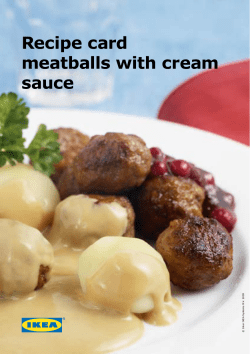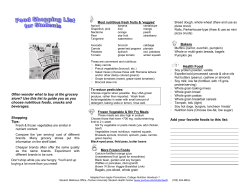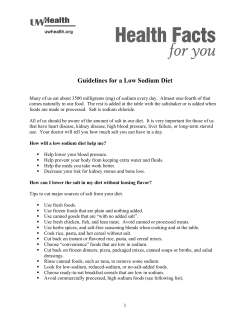
Diverse Foods and Flavours Healthy Diabetes Recipes from China
Diverse Foods and Flavours Healthy Diabetes Recipes from China A resource developed in collaboration with EatRight Ontario and George Brown College. Copyright ©, 2012 Introduction This booklet has been developed for healthy eating as part of diabetes prevention and management. It is a healthy take on traditional cultural dishes from China. The Canadian Diabetes Association has identified this community as being at higher risk for developing prediabetes, type 2 diabetes and diabetes complications at an earlier age (less than 40 years old) than the general population. Registered Dietitians at EatRight Ontario, faculty and culinary students at the Centre for Hospitality and Culinary Arts at George Brown College (GBC) partnered to create this recipe booklet to help address the need for culturally focused healthy eating diabetes resources. You can use the recipes to create healthy and balanced meals that make the most of your traditional favourites. This recipe booklet can be obtained online from the GBC applied research website (http://www.georgebrown.ca/research/projects.aspx#Food_Science) and from EatRight Ontario (www.eatrightontario.ca). What is diabetes? Diabetes is a condition whereby the pancreas either does not make enough of a hormone called insulin and/or the body cannot use insulin properly. Insulin’s role in the body is to take glucose (sugar) to the cells to be used for energy. With diabetes, glucose can build up in the blood and lead to high blood glucose levels. Over time, high blood glucose levels can lead to complications like kidney and heart problems, blindness and nerve damage. Healthy eating is important for diabetes management because blood glucose levels are raised by carbohydrate-containing foods like: • Fruit • Milk and yogurt • Grains • Legumes (dried peas, beans and lentils) • Starchy vegetables like potatoes and green peas • Sugars and sweets like desserts, ice cream, and candies Choosing healthy foods, exercising most days of the week, achieving a healthy body weight and taking medication as prescribed are all part of diabetes management. Healthy Eating for Diabetes Prevention and Management: Enjoy Your Cultural Foods If your goal is to prevent or manage type 2 diabetes you can still include many of the cultural foods that you enjoy. Continue to eat a variety of healthy foods, pay special attention to your portions and you will be on the right track! 1. Eat regularly throughout the day. Do not leave more than 6 hours between meals. 2. Eat higher fibre foods more often. Include whole grain breads and cereals, beans and lentils, brown rice, vegetables and fruit with their skins. Fibre can help keep blood glucose (sugar) at a healthy level. Fibre can also help manage body weight and blood cholesterol levels. 3. Eat smaller amounts of rice, noodles, roti, pasta, potatoes, cereal, breads and other starchy foods. Having large servings of these foods can make it more difficult to achieve healthy blood glucose levels. 4.Limit juice, regular pop, desserts, candies, jam, honey and other sweet foods. Having too much of these foods raises your blood glucose levels. 5. Limit higher fat foods like deep fried snacks and pastries. These foods can make it difficult to reach a healthy weight and manage your blood cholesterol levels. 6.Use fresh herbs and spices instead of salt or high sodium sauces to flavour your food. Too much sodium can lead to high blood pressure, heart disease, stroke and kidney disease. (Adapted from Just the Basics, Canadian Diabetes Association 2010). Try to make these healthy eating habits part of your regular routine: Understanding the Nutrition Analysis in this Recipe Booklet Fat Carbohydrate Many of the recipes in this booklet have tips to reduce fat when cooking. Too much fat, especially saturated fat, affects blood cholesterol levels. Limiting fats and oils is part of heart healthy eating. A Registered Dietitian can help you understand the amount of carbohydrate that you should aim for at each meal and snack. Generally, men can have 60 to 75 grams of carbohydrate at a meal and women can have 45 to 60 grams of carbohydrate at a meal. Snacks range from 15 to 30 grams. Sodium Healthy adults only need about 1500 milligrams of sodium each day. This is the amount of sodium in 2/3 teaspoon of salt. We all need some sodium in our diet but make sure to control the amount by always measuring the salt instead of adding a “pinch”. Too much sodium can lead to high blood pressure, heart disease, stroke and kidney disease. Fibre Adults with diabetes should aim for 25 grams of fibre or more each day. Food Choices The Canadian Diabetes Association has a food choices system called “Beyond the Basics Meal Planning” to keep track of your servings of carbohydrate, meat and alternatives, fats and extras. This system is a helpful tool for planning menus and meeting healthy eating goals for diabetes. Food choices are included in the nutrition analysis of recipes in this booklet. Your healthcare team can help you learn more about food choices and there is more information available at (www.diabetes.ca). Acknowledgements Professor Sobia Khan, RD, MSc , and the Centre for Hospitality and the Culinary Arts (CHCA) at George Brown College (GBC) have created an applied research project to serve the culturally-specific communities at high risk for diabetes (including South Asian, Chinese, Caribbean, and Latin American). One objective of this community-based research project is to develop and test culturally-specific recipes and make them healthier. The goal is to help prevent and manage prediabetes and type 2 diabetes in communities that are at increased risk. EatRight Ontario (ERO) provides free healthy eating advice from Registered Dietitians to everyone in Ontario. Residents of Ontario can call 1-877-510-510-2 and speak to a Registered Dietitian in over 100 languages. ERO has healthy eating information on a wide variety of topics, recipes, menus, videos and an “Email a Dietitian” service at (www.eatrightontario.ca). Examples of the free resources that are available from ERO include culturally adapted and translated diabetes information for South Asian (Urdu, Tamil, Gujarati, Punjabi, and Hindi), Chinese (Chinese), African and Caribbean (French), and Latin American (Spanish) cultures. GBC and ERO gratefully acknowledge the contributions of: • • • The Canadian Diabetes Association GBC contributors: CHCA culinary students; Chili Leung (photographer); Atanas Bozdarov (booklet designer); Quoc Bao Dang, Marcia Carby, Jiaqi Li, and Anthony Vargas (food stylist) Nutrition Analysis: Barbara Selley, RD (Food Intelligence) Flavours of China 1. Bird’s Eye Chilies or “Thai chilies” are small but they are very hot! Remove the seeds and membranes before adding these hot chilies to your dish—it will help reduce the heat but still allow the flavour to come through. 2. Bok choy is a type of Chinese cabbage with dark green leaves and juicy, crunchy white stems. Bok choy is popular in Asian cuisines. Bok choy is often steamed, added to stir-fries, and added raw to salads. Hint: When looking for bok choy choose smaller ones (i.e. baby bok choy) as they are usually more tender. 3. Star anise is actually shaped like a star! Star anise gives a licorice-like flavour and it is commonly used in savory Chinese meat dishes. 4.Szechwan or Szechuan pepper is not actually a pepper! This spice comes from the dried buds of the prickly ash tree and is originally from the Szechuan province of China. 5. Dried lily flowers or buds, also known as tiger lilies and golden needles, are unopened flowers of day lilies. They are yellow-golden in color and add an earthy or musky and slightly sweet taste to dishes like stir-fries. To use the flowers, the woody stem is cut from the bottom and they are soaked in warm water for about half an hour before being added to a dish. 6.Black fungus is also known in Chinese as little ear, cloud ear, tree ears, and jelly mushroom. They are sold mainly in dried form and can keep for up to 1 year if stored in an airtight container. This dried black fungus has been featured in Chinese cooking since the sixth century, mainly in soups and stir-fries. 7. Seitan is also known as wheat gluten or “wheat meat” because it is a vegetarian meat substitute. Seitan blends easily with other flavours. It has a chewy texture and it can be fried, steamed, baked or added to stews. Chinese Healthy Plate For a healthy and balanced meal, try to follow these portions: • 1/4 plate of grains (1/2 cup sticky white rice) • 1/4 plate of meat and alternatives (1/2 cup mapo tofu) • 1/2 plate of vegetables (1 cup bok choy and mushrooms) • 1/2 fruit (1/2 dragonfruit) • 1 serving of milk (1 cup soy milk) Nutritional Analysis Per plate Calories: ............................................... 551 Fat, total: ............................................ 16 g Fat, saturated: ..................................... 2 g Cholesterol: .................................... 13 mg Carbohydrates: ................................. 73 g Fibre: .................................................... 12 g Sodium: ........................................ 883 mg Protein: ............................................... 32 g Food Choices per Plate Carbohydrate: ........................................ 3 Meat and Alternatives: ........................ 2 Fat: ............................................................ 2 Extra: ......................................................... 1 When you understand plate portions, you can eat a variety of foods and still manage your blood glucose levels. Keep this picture of balanced portions in mind when you eat at home or in a restaurant. Baby Bok Choy and Mushrooms with Oyster Sauce Preparation time: 20 minutes Cooking time: 20 minutes Makes 2 servings Ingredients METHOD 2 tsp (10 mL) canola oil 3 cloves garlic, minced 1 tsp (5 mL) minced ginger 1/4 lb (125 g) fresh shiitake mushrooms, halved 1 lb (500 g) baby bok choy, rinsed and dried 2 tsp (10 mL) oyster sauce 2 tsp (10 mL) reduced-sodium soy sauce 1 tsp (5 mL) cornstarch 1. In a wok or a skillet, heat oil over Medium heat. Add garlic and ginger and stir-fry until fragrant and lightly browned. Nutritional Analysis Per Serving (1 cup) Tips: Calories: 109 Fat, total: 5 g Fat, saturated: 0 g Cholesterol: 0 mg Carbohydrates: 14 g Fibre: 5 g Sodium: 421 mg Protein: 5 g Food Choices Fat: 1 Extra: 1 2. Add mushrooms and stir-fry for 1 to 2 minutes or until tender. 3. Add baby bok choy and cook briefly; only until just wilted. 4. In a small bowl, combine oyster sauce, reduced-sodium soy sauce and cornstarch. Add mixture to pan and cook until sauce thickens; about 2 minutes. 1. The amount of oil has been cut down from the original recipe. When cooking with less fat, heat your pan before adding the oil—this will prevent sticking. 2. Dark or regular soy sauce and oyster sauce are high sodium ingredients often used in Chinese dishes. One serving (1 tbsp) can have up to 1000mg or more of sodium! Too much sodium can lead to high blood pressure, heart disease, stroke and kidney disease. Choose reduced-sodium sauces whenever possible. Shiitake mushrooms are used in this recipe—they are believed to be a symbol of longevity in Asia and hence why they are so readily used in Chinese cuisine. Braised Tofu and Eggplant • Preheat oven to 425 °F (220 °C) • 8-inch (2L) square baking dish Preparation time: 20 minutes Cooking time: 35 minutes Makes 6 servings Ingredients METHOD 1 package (350 g/12 oz) extra-firm light tofu, drained and cut into 1/2-inch (1 cm) cubes 1/2 tsp (2 mL) canola oil 5 cloves garlic, minced 2 bird’s eye chilies, minced with seeds and membranes removed 1 medium onion, large dice 2 tsp (10 mL) minced ginger 1-1/2 lbs (750 g) Chinese eggplant, cut into 1-1/2 inch (4 cm) spears 1-3/4 cups (425 mL) water 2 tbsp (30 mL) freshly squeezed lemon juice 2 tbsp (30 mL) reduced-sodium soy sauce 1-1/2 tbsp (22 mL) oyster sauce 1 tbsp (15 mL) natural rice vinegar 1 tsp (5 mL) cornstarch 2 green onions, thinly sliced 1/8 tsp (0.5 mL) white pepper 1. On a baking sheet, bake tofu cubes in preheated oven until lightly browned; about 20 minutes. Nutritional Analysis Per Serving (1 cup) Calories: 116 Fat, total: 3 g Fat, saturated: 0 g Cholesterol: 0 mg Carbohydrates: 12 g Fibre: 2 g Sodium: 338 mg Protein: 12 g Food Choices Fat: 1/2 Extra: 1 2. In a wok, heat oil over Medium-High heat. Add garlic, chilies, onion and ginger and sauté until fragrant. 3. Add eggplant and sauté for 2 minutes. 4. Add 1-1/2 cups (375 mL) of water and lemon juice. 5. Reduce heat to Low, cover and simmer, let braise for 10 minutes or until eggplant is tender. 6. Add tofu to wok and mix through. 7. In a small bowl, mix soy sauce, oyster sauce and rice vinegar. Once eggplant is tender, add sauce to wok and simmer uncovered for 3–5 minutes. 8. In a small bowl, mix cornstarch with remaining water and add to mixture to thicken sauce. 9. Add sliced green onions and white pepper and stir to combine. Tips: 1. Dark or regular soy sauce and oyster sauce are high sodium ingredients often used in Chinese dishes. One serving (1 tbsp) can have up to 1000mg or more of sodium! Too much sodium can lead to high blood pressure, heart disease, stroke and kidney disease. Choose reduced-sodium sauces whenever possible. 2. Compared to a common eggplant, Asian eggplants are longer and narrower with a sweeter taste. 3. Rice vinegar is made from fermented rice wine. This recipe calls for natural rice vinegar. Seasoned rice vinegar has added sugar and salt, and 1 tbsp can have as much as 250 mg of sodium in seasoned rice vinegar. This recipe features tofu and eggplant as the key ingredients. Tofu is an example of a heart healthy alternative to meat that is free of saturated fats and is a complete protein. Eggplant provides soluble fibre which has healthy impacts on blood cholesterol and glucose levels. Together, these ingredients make for a tasty combination! Mapo Tofu Preparation time: 10 minutes Cooking time: 15 minutes Makes 6 servings Ingredients METHOD 1/2 tbsp (7 mL) canola oil 3 green onions, thinly sliced 1 tbsp (15 mL) chili paste 1 tsp (5 mL) ground Szechuan pepper 1/4 lb (125 g) ground pork loin 1/3 cup (75 mL) and 1/2 tbsp (7 mL) water 2 tbsp (15 mL) Chinese cooking rice wine 2 tbsp (15 mL) reduced-sodium soy sauce 1 tsp (5 mL) dark soy sauce 1 tsp (5 mL) sugar 1 (500 g/16oz) package firm tofu, cut into 1/2 inch (1 cm) cubes 1/2 tbsp (7 mL) cornstarch 1 tsp (5 mL) finely chopped green onion 1. In a pot, heat oil over Medium heat. Add pork and stir-fry until pork is no longer pink in color. Nutritional Analysis Per Serving (1/2 cup) Tips: Calories: 159 Fat, total: 7 g Fat, saturated: 2 g Cholesterol: 13 mg Carbohydrates: 5 g Fibre: 0 g Sodium: 368 mg Protein: 19 g Food Choices Meat and Alternatives: 2 Fat: 1 2. Add sliced green onions, chili paste and Szechuan pepper, pork and stir-fry; about 2 minutes. 3. Add 1/3 cup (75 mL) water, cooking rice wine, reduced-sodium soy sauce, dark soy sauce and sugar; cook for 1 minute. 4. Add tofu, being careful not to stir as tofu will break. Reduce heat to Low, cover and simmer;about 5 minutes. Simmer, uncovered for 1 minute. 5. Add cornstarch mixed with remaining water and stir gently for 1 minute. 6. Garnish with green onion if using. 1. Dark or regular soy sauce and oyster sauce are high sodium ingredients often used in Chinese dishes. One serving (1 tbsp) can have up to 1000mg or more of sodium! Too much sodium can lead to high blood pressure, heart disease, stroke and kidney disease. Choose reduced sodium sauces whenever possible. 2. Chinese cooking rice wines have a lot of added salt. Using a drinking wine is another option that will reduce the overall sodium content. Another substitute is a Japanese rice wine like Sake which is more readily available but they are more expensive than the Chinese cooking wines. 3. Due to the reduced fat content, be sure to cook this dish mostly over Low heat so that it does not dry out. Typically, this dish is meant to be saucy. This dish is from the Szechuan region of China. The cut of meat used was pork loin and the amount reduced to lower the fat content. Braised Seitan with Peanuts and Black Fungus • Non-stick pan Preparation time: 20 minutes Cooking time: 15 minutes Makes 4 servings Ingredients METHOD 1-1/4 cup (310 mL) seitan (kaofu) or fresh wheat gluten, cut into 1 inch (2.5 cm) thick pieces 1-1/2 tbsp (22 mL) canola oil 1 tsp (5 mL) minced ginger 1 piece star anise 5 dried Chinese mushrooms, soaked and diced 1 cup (250 mL) dried black fungus, soaked and diced 1/3 cup (75 mL) dried daylily, soaked and cut in half 1/3 cup (75 mL) unsalted peanuts 1 cup (250 mL) water 2 tbsp (30 mL) low-sodium vegetable stock 2 tbsp (30 mL) sugar 1 tbsp (15 mL) reduced-sodium soy sauce 1 tbsp (15 mL) dark soy sauce 1/4 tsp (1 mL) sesame oil 1. Soak seitan (kaofu) in cold water for more than 2 hours until fully soft. Soak dried mushrooms, dried black fungus and dried daylilies in cold water separately for 30 minutes, until fully soft. Rinse these ingredients thoroughly and set aside. 2. In a pan, heat oil over Medium heat. Add ginger and star anise until fragrant; about 1 minute. 3. Add mushrooms, fungus, daylilies and peanuts, cook uncovered for about 4 minutes. 4. Add seitan (kaofu), water, low-sodium vegetable stock, sugar, reduced-sodium soy sauce and dark soy sauce. Bring to boil over High heat. 5. Reduce heat to Low, cover and cook for 12 minutes. Dish is supposed to have some sauce so ensure it does not get too dry. 6. Remove from heat, and drizzle sesame oil over the dish. Mix and allow to cool before serving. Tips: Nutritional Analysis Per Serving (1 cup) Calories: 278 Fat, total: 11 g Fat, saturated: 1 g Cholesterol: 0 mg Carbohydrates: 30 g Fibre: 9 g Sodium: 377 mg Protein: 19g Food Choices Carbohydrate: 1/2 Meat and Alternatives: 2-1/2 Fat: 1-1/2 1. To minimize the sodium in this recipe make your own stock if possible or look for stock that has no sodium added. Also, seitan can have added salt, so check the Nutrition Facts panel to find a brand with little salt added. 2. Dark or regular soy sauce and oyster sauce are high sodium ingredients often used in Chinese dishes. One serving (1 tbsp) can have up to 1000mg or more of sodium! Too much sodium can lead to high blood pressure, heart disease, stroke and kidney disease. Choose reduced sodium sauces whenever possible. 3. Non-stick pans require good care in order to protect the nonstick coating. Health Canada states that nonstick coatings using Teflon (polytetraflouroethylene or PTFE) are a risk if they are heated to temperatures greater than 350°C or 650°F because they can give off an irritating or poisonous fume. It is not recommended that non-stick pans be used frequently. It is being used in this dish to keep the fat content low and get optimal results. In Shanghai, China, this dish is called “Four-Joy KaoFu.” This dish is typically served cold along with Chinese liquor and beer. It can be made vegetarian as it is in this recipe or it can be made with added pork—although this would increase the total fat and saturated fat of this dish.
© Copyright 2025




















